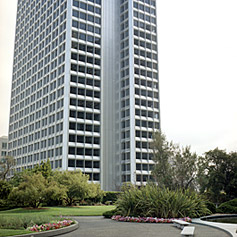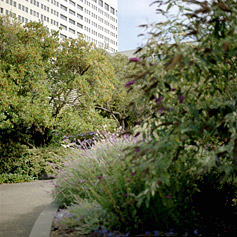
Kaiser Center
Oakland, California
history continued
The garden is significant in itself as the first true post-World War II roof garden to be built in the U.S.
Osmundson liked to make the distinction that the Union Square garden (San Francisco, 1942) and the Mellon Square garden (Pittsburgh, 1955) were street level gardens, covering multi-level underground parking garages and were, therefore, not true roof gardens, elevated several stories above ground level, as the Kaiser roof garden is. Unlike so many of the roof gardens built during that time and even today, the Kaiser roof garden continues to be a pioneering example of the intensive-style roof garden in the U.S. At the time it was built, it was the largest contiguous roof garden in the world. Moreover, it conveyed all the aspects of a garden at ground level, employing a full complement of trees, shrubs, perennials, and turf. This was, and still is, a vast departure from the roof gardens which only feature small collections of potted plants or raised beds. The only other comparable structures from the period are those of Ralph Hancock including the gardens atop Rockefeller Center (which were never fully implemented due to the economic effects of the war) and the Derry and Toms department store (London, 1938) and those of Roberto Burle Marx in Brazil and, indeed, the influence of Marx's design work can be seen in Arbegast's plan for the Kaiser Roof Garden.

